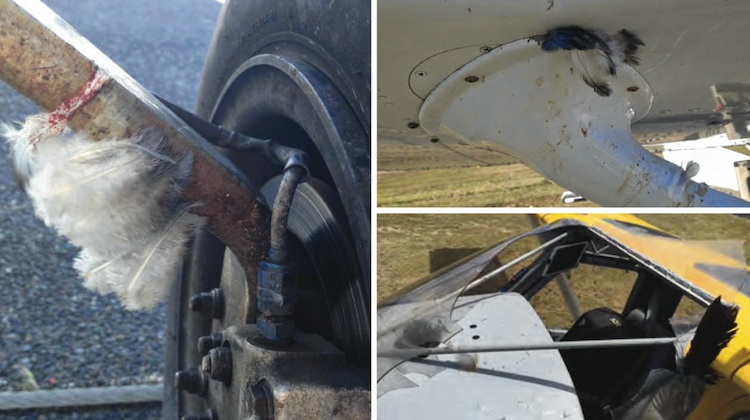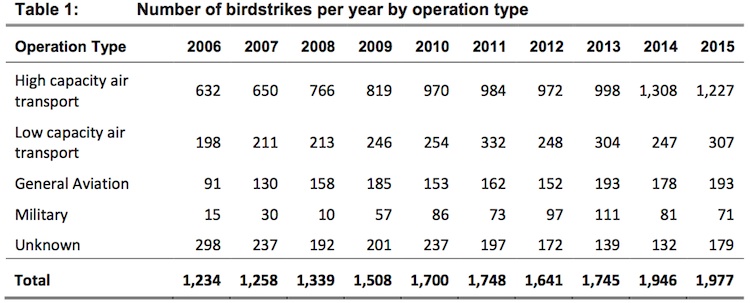
There has been a significant increase in the number of birdstrike incidents over the past two years involving high capacity aircraft operations, new figure show.
The findings were part of an Australian Transport Safety Bureau (ATSB) report into birdstrike events recorded over the past 10 years.
The report said there were 16,069 birdstrikes reported to the ATSB between 2006 and 2015.
The two years with the greatest number of incidents took place in 2014 and 2015, when there were 1,946 and 1,977 incidents, respectively.
The ATSB report noted the bulk of birdstrike incidents involved high capacity air transport services, defined as “regular public transport (RPT) and charter operations on aircraft certified as having a maximum capacity exceeding 38 seats or a maximum payload exceeding 4,200kg”.
“Both the number and rate of birdstrikes per 10,000 movements in high capacity operations have increased markedly in the past two years 2014 – 2015,” the ATSB report said.
“In contrast, the number of birdstrikes in low capacity operations and general aviation has remained relatively consistent.
“In the two years since 2013, the rates for six of the 10 major airports have increased relative to ten year averages. The largest increase in the rate of birdstrikes was observed at Cairns, Canberra, Darwin, Gold Coast and Sydney.”


The ATSB report said there have been only 10 reported birdstrike incidents in the 10-year period 2006-2015 that have resulted in injury.
Of those, eight occurred in general aviation, while two involved low capacity air transport operations. The ATSB said the injuries were minor in all cases.
The ATSB report said the four most common flying animals involved in birdstrike incidents in 2014-2015 were bats/flying foxes, swallow/martins, kites and lapwings/plovers.
“Swallows and martins had the most significant increase in the number of reported birdstrikes per year in the last two years, with these species being involved in an average of 96 birdstrikes per year for 2014 and 2015 compared with 65 per year on average across the entire 10-year reporting period,” the ATSB report said.
“Galahs were more commonly involved in birdstrikes of multiple birds, with more than 38 per cent of galah strikes involving more than one galah. However, larger birds were more likely to result in aircraft damage.
“For every 1kg increase in animal mass, the likelihood of a birdstrike causing damage increases by 12.5 per cent.”
Meanwhile, the ATSB said the most common time for birdstrike events was 0730-1030.

















Greg
says:Where is Sully when you need him.
Peter Griffiths
says:I work for one of the largest seed producing companies in the world. Company is called DLF. Currently I live in Christchurch, New Zealand as the Turf Seed Sales Manager for NZ & Australia.
DLF run global trials at airports with different seed varieties to reduce the risk of bird strike. Our philosophy is that one variety or system doesn’t suit everyone. By running such trials globally we believe we can reduce the risk of bird strike at airports by creating a suitable management program.
I travel to Australia frequently and would love the opportunity to discuss these trials with operation managers at any of the airports listed above.
I currently have 2 sites in New Zealand, Queenstown and Wanaka airports. Plus many more around the world.
Adrian P
says:How many were on the runway and how many were airborne below 5000 feet ?
The timing between 0730 and 1030 could suggest the birds will avoid the aircraft routings once established for the day. The gulls at the College of Air Training, Hamble would roost on the airfield with no problems until we changed the runway in use, so we shuffled them to a new location using a vehicle.
No good having bird control on the airports when runway approach has forests, lakes and bays.
Gerald Casimatis
says:I am surprised that pelicans, ibis, crows, swifts,lorikeets and shags are not listed. Driving past Sydney airport each morning I regularly see large numbers of these birds near parked and taxiing aircraft.
Just so I can be a bit annoying are not kites and kestrels hawks?
Linda Weaving
says:No. Kites, Hawks and Eagles are all different families within the order Falconiformes. Kestrals are in the Falcon family along with, you guessed it, the Peregrine Falcon.
Linda Weaving
says:What does this say about the intelligence of building a new airport only 8km from a bird rich World Heritage listed National Park AND zoning adjacent land as ‘agribusiness’ AND including wildlife reserves WITHIN the airport?